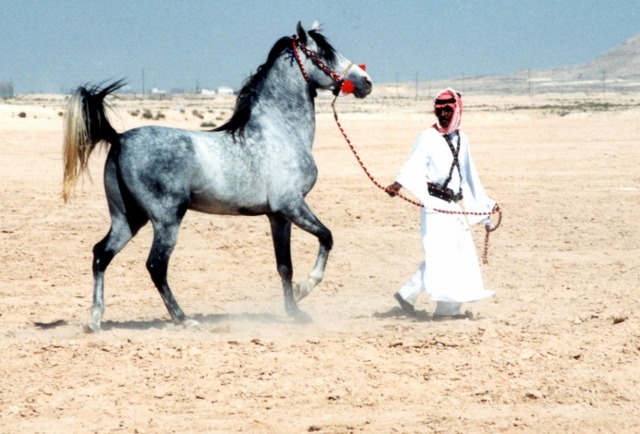The real Drinker of the Wind
In a comment on an earlier post, Laszlo reminded us of this quote from Valerie Noli-Marais in an article from a 1972 Arabian Horse News issue about the horses of Bahrain:
“When a Bahrain Arabian horse is taken off its hobbles and proudly bursts into motion, with mane flying, dark kohl ringed eyes flashing, tail straight up like a banner and arching his long neck, it is a sight to bring tears to the eyes of any horse lover – for truly it is he – the real Drinker of the Wind…
The wonderful photos Matthias Oster has been featuring here over the past two days are an illustration of this. So is this photo of Saidan Gharib at the 1998 WAHO conference in Bahrain.
One of the things I loved the most about these Bahraini horses is how different stallions are from closely related mares, often their sisters and their mothers. Just as in wildlife, there is a differentiation between the male and the female, which has almost been erased in the show horse. Bahraini stallions exhibit strong primary masculine features like thicker necks, while mares’ neck are much thinner.

Additional citation from Dr.Valerie Noli-Marais:
..”The stallions are between 14.3 and 16 h.h., very masculine, short-backed and compact,with long powerful necks,with prominent crests, good withers, broad and deep chests, andtremendously powerful quarters.Topéine are good and tail carriage is truly magnificent. the legs apart from disfigurement by the shackling,are excellent and dry with large flat knees,short pasterns and large strong hooves…
The mares are smaller, 14.2 to 15 hands high, feminine, with finer heads,more to our western taste. some had quite good dished profiles, although this factor is not mentioned in the traditional standards.
When questioned about the “dish”,it was apparent that this was not sought after or bred for, but happened to be present in some horses. It is tolerated in mares but not in stallions.”..
Best wishes,
László
One saw that in the Babson Egyptians years ago. If you can find a photograph of Disaan, you can see the crest on his neck as he ages, which was not on the mares.
I love this horses solidness. He is indeed beautiful. I love the look of his powerfulness. He fits the description perfectly.
Saidan Gharib..it means Gharib from the strain of Kuheilan Said, I think.
It would be good to know, whether Kuheilan Said equals Kuheilan Zaid?
Studying the first and the second volume of the Bahraini Studbooks, I thought about the naming system.
The names of the horses included strainname and substrain name too, but not always. Sometimes no substrain and sometimes the substrain enter the place of the strain name. Not consequent. For example Kuheilan Aafas Ttaawoos (grey stallion).Here the strain is Kuheilan, the substrain is “Aafas” and the personal name is “Ttaawoos”.
I would think that, a M’anaghy horse must have a substrain in this environment too. But the name is Ma’anaghy Nadeem …or other examples Obeyah Matra, Hamdanieh Marwa, Saqlaawy Gharib, etc.etc. Where are the substrain names?
My questions are: How, when, why, where lost an arabian horse the substrain?
Back to the names of the studbooks.
Many names derived from the substrain, mostly in the case of Kuheilans. For example Jellaby,Krush, Kray, etc. plus one personal name.( Jellaby Kher,etc.etc.)
The substrain name take the part of the strain name.
But not in every case. For example Kuheila’t Umm Zorayr Nawwaarah.Strain name, substrain name, Personal name.
Interesting,maybe only for me,or for us westerners?
Best wishes,
László
the crested heavier neck is a sign of virility and strength-and i find it a beautiful sight-on the upright neck it is a blessing.